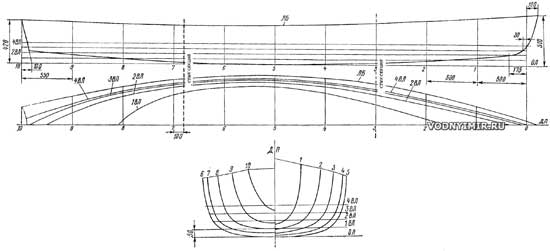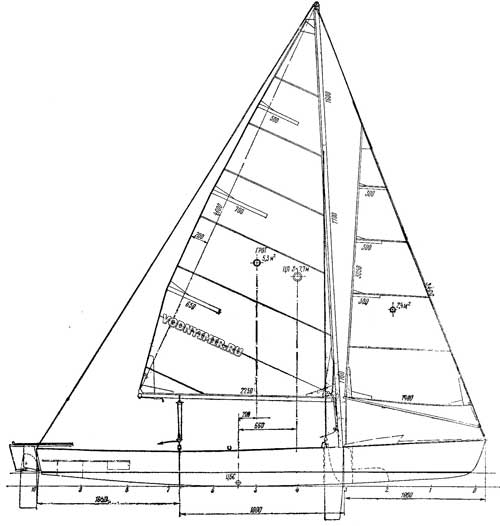Universal boat — sectional fiberglass canoe
I prize at the NTO competition
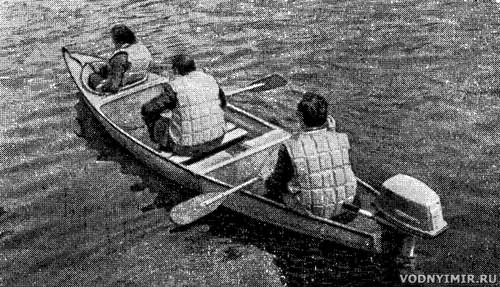
On the pages of the collection, the issue of has been repeatedly discussed about the creation of a light and truly universal boat, which would be convenient for tourists, hunters, fishermen and when used by various expeditions, capable of swimming both along mountain rivers and in reed-overgrown floodplains, on which it would be possible to put a motor and sail. Our team of authors offers a variant of such a boat for self-construction of fiberglass. When designing it, we tried to take into account the experience of participants in tourist competitions, the opinions of water tourism instructors, water tourists from Moscow, Leningrad, Petrozavodsk and other cities of the country.
With serial construction, such boats could become the main type of vessel at many camp sites, replacing both easily vulnerable and short-lived collapsible kayaks and heavy, inconvenient planks for delivery back to the base, «fofans» and «Pella».
The ability to transport a boat in the form of a package, the weight (50 kg) and dimensions (1,02x0,6x1,9) of which allow transportation on the upper trunk of any car, obviously, will interest amateur tourists.
The canoe is disassembled and prepared for transportation
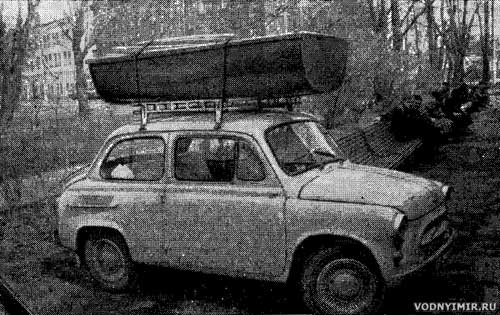
According to the authors, the choice of routes when using the proposed type of canoe will be much wider than when using conventional collapsible kayaks with a soft skin.
General view of a three-section fiberglass canoe assembly
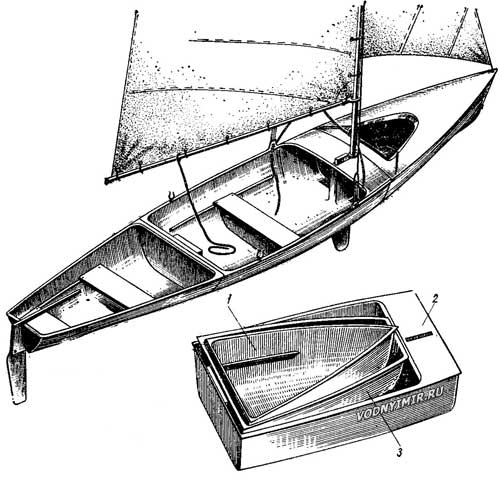
Option with a closed bow — under sail and disassembled — the bow section is stacked in the stern and middle.
1 — bow section; 2 — middle section; 3 — aft section.
| Basic data of the universal boat | |
|---|---|
| Length, m | 5,15 |
| Width, m | 1,00 |
| Draft at full displacement, m | 0,20 |
| Total displacement, kg | 465 |
| Completeness coefficients: | |
| waterlines α | 0,7 |
| midsection frame β | 0,89 |
| overall completeness δ | 0,53 |
| Side height in the bow/amidships/transom, mm | 510/385/420 |
| Passenger capacity, people. | 4 |
With a shorter length than the «Salyut-5.2», the payload of the sectional boat is higher: 410 kg versus 350 kg. This gives reason to consider the boat in the recreational and tourist version as a four-seater. The authors tried to preserve such advantages of widespread «Salutes» as ease of rowing and greater cross-country ability, and at the same time make the boat more durable, reliable and durable, better adapted for carrying sails or a motor, convenient for quick loading and unloading luggage. The starting point for the creation of such a multipurpose boat was the foreign experience in the construction and operation of 5-meter canoes, i.e. boats that are almost completely unknown to our tourists.
The contours and dimensions of the boat were finally chosen after a three-year study of the issue. The relatively narrow hull of the boat has an almost flat bottom with a small radius cheekbone, which provides low draft, high stability, satisfactory driving performance when planing under the engine. The rise of the keel line at the extremities improves the agility of the boat, which is especially important when descending rivers with a fast current or sailing. However the canoe does not leave the circulation on its own; those who are not satisfied with this will have to hang the steering wheel or install a small triangular fin on the stern under the keel.
Theoretical drawing of the boat
Table of plaz ordinates
| shp no. | Half-width from DP, mm | Heights from OL, mm | |||||
| 1BL | 2BL | 3VL | 4VL | Bort — LB | Keel | Bort — LB | |
| 1 | — | 80 | 115 | 135 | 180 | 200 | 500 |
| 2 | 60 | 195 | 232 | 245 | 305 | 72 | 470 |
| 3 | 190 | 295 | 330 | 350 | 400 | 30 | 432 |
| 4 | 310 | 375 | 405 | 418 | 460 | 20 | 415 |
| 5 | 370 | 415 | 440 | 452 | 480 | 0 | 390 |
| 6 | 370 | 415 | 435 | 445 | 475 | 0 | 385 |
| 7 | 295 | 365 | 390 | 405 | 440 | 20 | 390 |
| 8 | 50 | 280 | 320 | 335 | 375 | 45 | 400 |
| 9 | — | 120 | 185 | 210 | 285 | 80 | 415 |
| 10 | — | — | — | 65 | 175 | 120 | 420 |
The waterlines, sharp in the bow of the boat, are made full in the stern. The displacement of the largest width of the boat from the middle to the stern reduces the trim that occurs when sailing alone (for example, when crossing) or running under the motor.
The hull is a non-assembled (shell) fiberglass structure divided into three sections with paired waterproof bulkheads at the joints.
The layout of the collapsible canoe
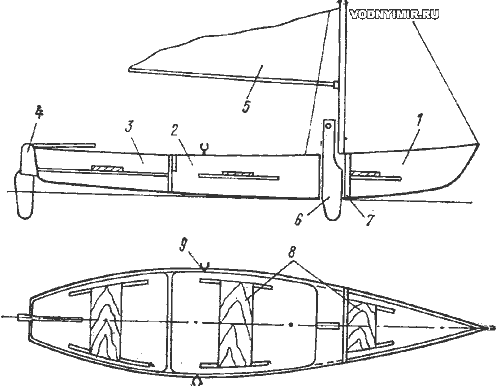
1 — nasal section; 2 — middle section; 3 — stern section; 4 — steering device; 5 — sailing armament, 6 — mooring; 7 — screw connection of sections; 8 — removable banks; 9 — rowlocks.
The sections are connected to each other by bolts with sealing rubber gaskets. Molded in the middle part of the boat on a flat bottom, two corrugations will serve as stiffeners and at the same time protect the bottom from abrasion. Ledges on the sides also provide rigidity of the structure and serve as supports for removable cans (for simplification of the case, an option with molding along the smooth sides of the slats may be recommended). A wooden gunwale can be laid on the flange along the upper edge of the side.
Checking the strength of the canoe assembly
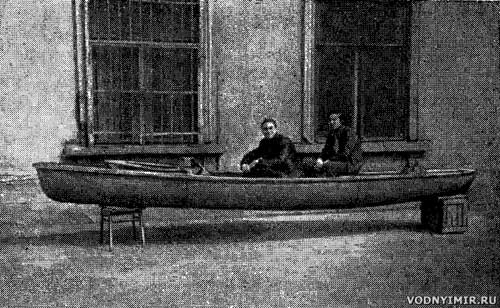
Load — 150 kg.
The split into three sections of unequal length and the asymmetry of the hull relative to the midsection not only solve the problem of stacking sections one into another (bow to stern and middle) for storage and transportation, but also allow the boat to be used in several variants.
Options for using a sectional canoe
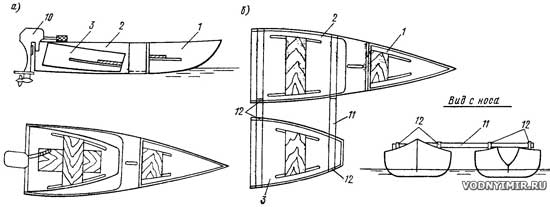
a — with an outboard motor assembled from two sections; b — as a catamaran.
Items 1-9 — shown in the diagram of the canoe device; 10 — outboard motor; 11 — transverse beams made of aluminum pipes; 12 — clamps for fixing beams.
A boat of three sections goes well on oars and under sail; when installed on the transom of the aft section 2-horsepower motor «Salyut» or «Sputnik» moves in displacement mode, even with full load developing a speed of 8-10 km/h. Under with the motor «Breeze» the boat is in transition mode, respectively, at a higher speed.
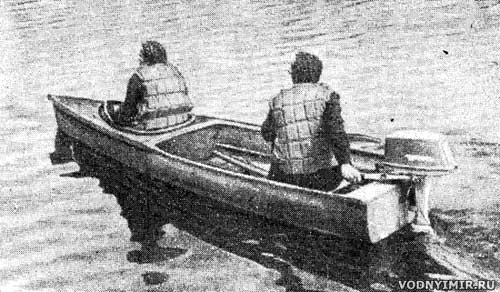
The joint of the middle and aft sections is located at the place of the greatest width of the boat and where the keel line is lowered down as much as possible. The aft bulkhead of the middle section is reinforced with the expectation of installing a powerful outboard motor up to 25 hp. This makes it possible, by disconnecting the aft section and leaving it on the shore (or laying it in the middle section), to get a planing mini-motorboat 3.5 m long with a wide transom.
The hydrodynamic quality of the bottom can be improved by filling the space between the corrugations with a long wedge of foam and pasting it with fiberglass. It will turn out to be a narrow «ski», thanks to which the speed will noticeably increase when running with a low load. In this case, the aft section will have to provide for an appropriate «escape» — nullifying the resulting ledge on the bottom.
When driving with a powerful motor, transporting cargo, towing a water skier, swimming in conditions associated with the risk of capsizing, it is worth turning a canoe into a catamaran. For this purpose, the aft section is placed parallel to the middle one with its narrow transom forward. The sections are connected using poles, two duralumin tubes included in the ship's kit, or a mast and boom of sailing armament. The pipes are attached to the gunwale (flange) using semicircular clamps. The motor is mounted on the transom of the middle section. Such a catamaran has stability, reliably ensuring the safety of navigation even in the excitement or when rafting on a stormy river. Naturally, he will also go on the oars: he will have to work with strokes from the outer sides.
Stability was tested on two boats built in 1977 by landing one passenger directly on the gunwale: at the same time, the height of the freeboard on the roll side was 100 mm. Restoring moments at a displacement of 465 kg: for a roll angle of 10° — 38 kgf ·m, for 15° — 57 kgf ·m. It can be noted that the values of the restoring moment are greater than those of the Salyut kayaks comparable in size and «Taimen».
The unsinkability of the canoe is ensured by fixing foam blocks with a total volume of 70 liters inside the hull.
To improve the seaworthiness of a boat in a dangerous situation, you can put a dacron deck on the hull, resting in the bulkhead area on inflatable rubber arches made of cut bicycle chambers.
Naturally, it should always be remembered that such a light boat is not a fofan, and the requirements imposed on ordinary heavy and wide rowing or, especially, motor vessels are not applicable to it.
When hiking on the bottom, it is recommended to lay a foam mat for collecting water. It is not difficult to squeeze it periodically; it will prevent the transfusion of water into the boat, which significantly reduces stability!
The 1.6 m long bow section serves to accommodate one rower working with a canoe paddle or a conventional two-bladed kayak paddle. Foam buoyancy blocks form an easily removable seat here.
Rigid deck of the bow section
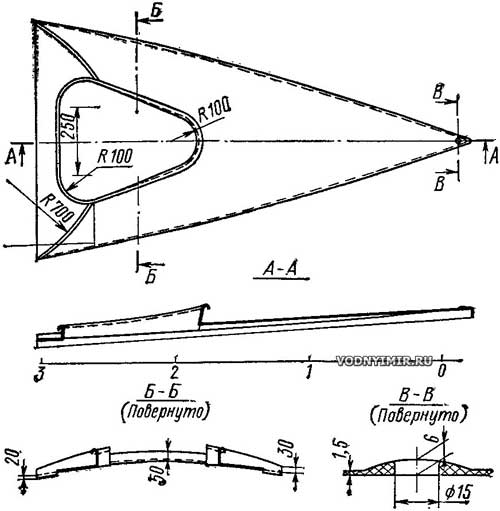
When counting on difficult sailing conditions, the bow section should be closed with a rigid deck with a high coaming around the hatch for landing the rower.
The middle section is the largest. Its length is 1.9 m. This is a cargo compartment or (in a four-person walking and tourist version) a place where two crew members are located. For swimming in simple conditions over long distances, it will be useful to install folding rowlocks on the sides for rowing with paired swing oars sitting backwards. In the bow of the middle section, a mooring well is mounted, rigidly connected to the bulkhead. To simplify matters, a «dagger» type screw is provided, freely inserted into the well from above. A mast stands on the top of the well.
General view of a universal boat with sailing armament
Note that by raising a 5 m mainsail and a 2 m staysail on the mast, it is easy to turn a canoe into a fairly fast sailing vessel. Amateurs who are not yet experienced in sailing are recommended to walk with only one grotto of a reduced area — no more than 3-4 m² (you can advise using sailing weapons from a child's the «Optimist» class boat).
The aft section is 1.65 m long and has a transom raised above the water, respectively, designed for an outboard motor with a capacity of up to 8 hp and a mounted rudder with a lifting feather with an area of about 0.1 m². This section has a removable seat and a foam buoyancy unit. Sitting here, as in the bow section, it is convenient to row with a single-bladed paddle or a two-bladed kayak paddle; the hull in the stern is quite narrow.
Each of the sections, as we have seen, can independently swim with one, and the middle one even with two people on board.
The prototypes of the boat weigh 50 kg. When forming them, we laid 2 layers of TZHS fabric (0.6 mm each), and 1 layer of satin weave fabric (0.3 mm) on the outside and inside of the case, without trying to squeeze out the fabric especially. The re-cuts were not cut off, so a thickness of up to 3-4 mm was obtained on the bottom, bulkheads and along the edge of the side. With careful work, you can significantly reduce the weight of the finished case — up to 30-35 kg.
General arrangement of the canoe
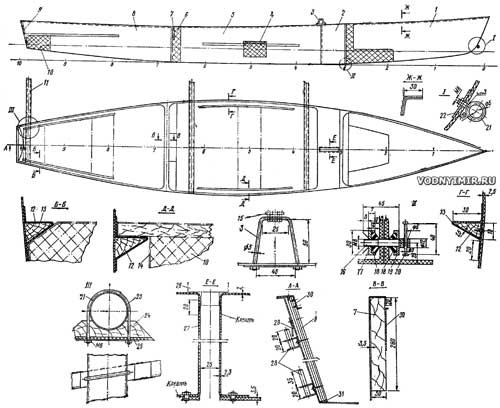
zoom in, 2538x2070, 664 KB
Simplified version — without corrugations on the bottom.
1 — bow section; 2 — mooring well; 3 — shrouds; 4 — removable bank; 5 — middle section; 6 — reinforcement for the motor made of foam; 7 — engine board; 8 — aft section; 9 — plywood transom glued to the fiberglass skin; 10 — foam; 11 — pipe Ø40 made of light alloy for connecting two boats into a catamaran; 12 — wooden bar 20x30; 13 — pasting with three layers of fiberglass; 14 — pasting with a layer of fiberglass; 15 — «rope lanyard»; 16 — screw M8; 17 — special nut M8; 18 — rubber washer; 19 — metal washer; 20 — collars; 21 — nose ring; 22 — bar 2x25x40; 23 — rod clamp Ø6; 24 — cushion; 25 — pla 3x15x80; 26 — mast steps; 27 — mooring well; 28 — steering loops; 29 — steering stopper; 30 — metal plastic; 31 — bujirovka (sealing putty).
To build a canoe, a form (punch) was made from slats, and then a fiberglass matrix was glued on it for the entire length of the boat. In this matrix, all three sections were formed in turn.
The middle section was formed first. To do this, plywood templates of both transverse bulkheads limiting the middle section were installed and fixed with plasticine (from the extremities) into the matrix strictly according to the marking. A separating layer was applied to the templates (from the midsection side) and the working surfaces of the matrix in the area between them and fiberglass was laid on a polyester binder. Then the plywood templates were removed; when forming the sections of the extremities, the bulkheads of the finished middle section remaining in the matrix served as templates.
The canoe according to the given theoretical drawing can also be made of any sheet material, for example plywood, by stitching along the grooves and joints with soft copper wire, and then gluing the joints with fiberglass strips. With a plywood version of the design, it will be necessary to reinforce the body with 20x30 cross-section break bars.
Here are sketches of the cutting of the details of a plywood canoe of the same length, but with somewhat simplified contours.
Cutting parts for the construction of plywood canoes
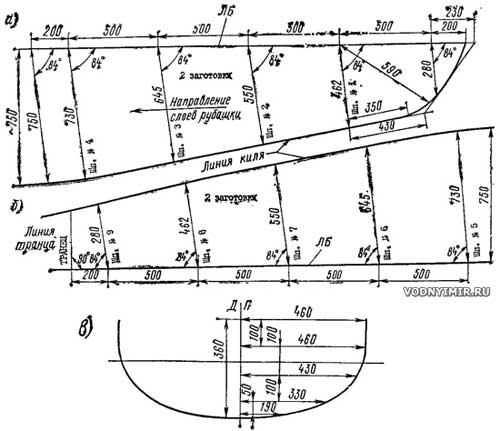
zoom in, 1297x1128, 159 KB
a — the forward half of the hull; b — the aft half of the hull; c — the outlines of the bulkheads.
In the middle part of the body (at a length of 700 mm) there is a so-called cylindrical insert, i.e. a section with the same cross-sections along the frames; thanks to this, the panels of the transverse bulkheads on shp. 4 and 5 are cut out according to the same template. The bulkheads are fixed upwards with the keel on some flat surface (the distance between them is 700 mm), after which the middle part of the boat is sheathed with a sheet of plywood 700x920. Plywood is attached to the bulkhead binding (rail 20x30) with screws, starting from the DP to the sides. The billets of the hull of the bow and stern parts are sewn together along the DP (keel line) with soft wire, and then the bow and stern are docked to the finished middle section. At the same time, the edges of the plywood, which have been previously «nullified» at a length of about 200 mm, are applied to the ends of the middle section prepared in the same way. When installing the rest bars, it is important to ensure smooth bending of the side line; usually you have to put spacers, etc.
It is not difficult to turn the same canoe into a three-section collapsible: you will need to break the hull into sections and put paired bulkheads along their edges.
Boat projects for self-construction
Share this page in the social. networks or bookmark:

